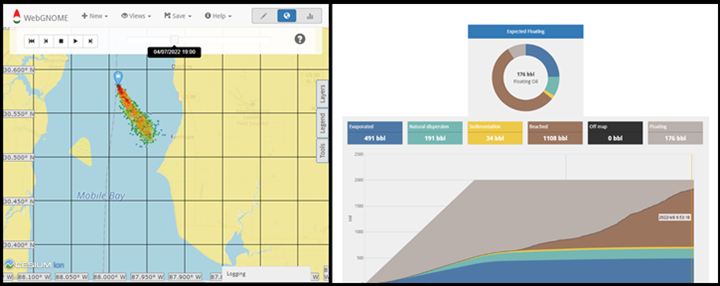WebGNOME
WebGNOME is a publicly available Web-based application that provides a user-friendly interface for modeling oil spill scenarios. WebGNOME allows users to easily set up a custom spill scenario, run the model, and visualize the results.
When provided with oil data from the ADIOS Oil Database, a full oil weathering analysis is also provided. WebGNOME can also be used for non-oil scenarios, for example, predicting vessel drift.

Right (larger view): Oil fate (weathering) view from WebGNOME, showing an oil budget for a simulated spill.
Typical Uses for WebGNOME
- Examine how an oil might weather and change when spilled (using the Weathering Only mode, similar to the desktop ADIOS model).
- Examine how oil might be transported in a pre-configured location (using specific Location Files). WebGNOME comes with about 30 pre-configured Location Files, mostly in the United States. They are configured to capture the general climatology of a region, and with a few additional inputs, can provide realistic simulations suitable for intuition building and drills/exercises.
- Examine how oil might be transported in a region of interest. If your location is not one of the pre-configured locations, then the model can be fully customized for your location (using Manual Setup). In this case, you must provide a land-water map, and winds and currents for the time and place of interest. Many WebGNOME-compatible data sets are provided through NOAA's GOODS (GNOME Online Oceanographic Data Server) Web application, but you can also provide winds and currents from the results of other models. WebGNOME supports using input from a variety of meteorological and oceanographic models.
- Examine how spilled oil might be transported and weathered. Oil weathering and transport can be computed at the same time by including oil information downloaded from the ADIOS Oil Database. This can be done using one of the pre-configured Location Files or with your own custom setup.
Limitations of WebGNOME
WebGNOME is designed primarily for the modeling of surface fate and transport. Some features that exist in the PyGNOME package (the computational core for the GNOME suite) are not yet available through the WebGNOME interface. For some complex modeling needs, the PyGNOME package may be more suitable.
Some examples of functionality that is not yet available in WebGNOME include:
- Three-dimensional simulations
- Oil-in-ice interactions
The underlying algorithms exist in the PyGNOME package, but an interface for initializing and visualizing these scenarios is still under development.
Some computationally expensive simulations are not well suited for a Web-based application which is running on a remote server. These include:
- Very large-scale simulations (in space or time). For example, many months of results from a 3D oceanographic model are simply too large to upload and download to a remote server at run time. To address this use-case, the WebGNOME stack can be installed and operated on a single laptop or workstation. In this case, the data files can be pre-loaded and accessed directly by the server without needing to upload and download any data at run time. A simple installer for this is part of NOAA’s future development plans.
- Running many simulations for stochastic (probabilistic) modeling applications or as an automated process. PyGNOME can be used directly and driven with scripts written in the Python programming language. This gives you full flexibility and power to both control every detail of the model configuration and interact with external data sources and Web services.
For more information about running simulations locally, see the information page about PyGNOME.
Questions: Contact us with your questions, comments, or suggestions for GNOME.
 An official website of the United States government.
An official website of the United States government. 